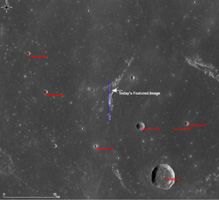Fresh and degraded craters in Oceanus Procellarum, near the crater Flamsteed P. Illumination is from left side of the image, incidence angle is 78°, width is 1400 meters.
This image is a great example of typical young and old craters. The crater on the right with lots of boulders spreading out of the cavity is a young, fresh crater. The crater to the left has a smoother surface without recognizable boulders, and has an overall subdued or degraded shape. They are about the same size and both formed in mare basalt. The older example likely had a similar morphology when it formed originally.
Astronomical numbers of small impacts over time are believed to be the main factor breaking boulders into small pieces and smoothing the surface (think of this process as cosmic sand blasting). If you are very patient, visit the crater on the right in about a billion or two years and you will see it looking similar to the degraded crater on the left. Be careful though -- when you show up the crater on the left may no longer be around.
 |
| Click on image for larger version |
| Context view of today's Featured Image. Blue box indicates the NAC frame, and white arrow points out the location of the two craters. Image center is 2.47° S, 314.26° E. LROC WAC mosaic, 100 m/pixel |
NASA's Goddard Space Flight Center built and manages the mission for the Exploration Systems Mission Directorate at NASA Headquarters in Washington. The Lunar Reconnaissance Orbiter Camera was designed to acquire data for landing site certification and to conduct polar illumination studies and global mapping. Operated by Arizona State University, LROC consists of a pair of narrow-angle cameras (NAC) and a single wide-angle camera (WAC). The mission is expected to return over 70 terabytes of image data.

